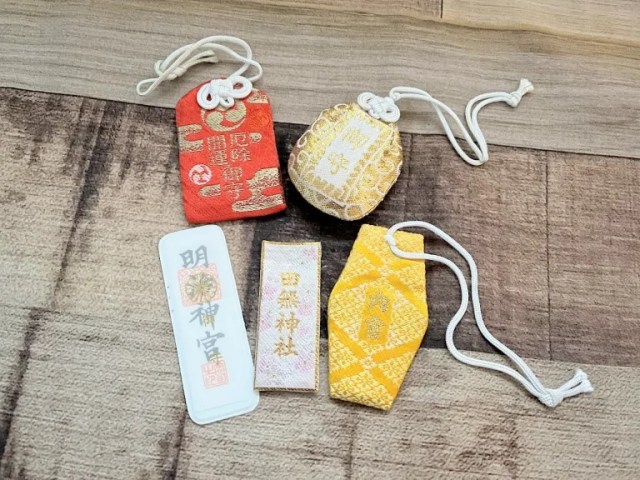
Japan has tens of thousands of shrines and even more omamori amulets, but is it OK to stock up on multiple blessings?
As anyone who’s played an RPG can tell you, there are often rules and limits as to the number of amulets, talismans, and other accessories that are said to grant divine protection and other benefits upon their bearer. So we found ourselves wondering, do the same sort of rules apply to the omamori charms sold at shrines in Japan?
Omamori are a compact version of ofuda, strips of paper prepared by Shinto priests that provide blessings. For omamori, the paper is placed inside a cloth pouch that’s often covered in decorative embroidery and bears the name of the shrine and the effect the charm is said to have.
Omamori can come in a variety of shapes and sizes, but the most common resemble the ones in the photo above, roughly rectangular and fitting in the palm of your hand. Some of the most popular types of omamori are the enmusubi omamori (which provides fortuitous connections such as finding a new romantic or business partner), gakugyo omamori (for passing tests and good results in other academic endeavors), kotsuanzen omamori (for safety when traveling in cars trains, or other modes of vehicular transportation), and anzan omamori (for an easy birth of a healthy baby), and there are also omamori for such broad concepts as “victory.”
▼ There’s even a shrine in Kyoto where you can buy omaori for severing ties with people who’re having a negative effect on your happiness in life.
With so many different types of omamori available, and certain shrines having cultural connections that supposedly make their omamori for certain goals especially potent, it’s pretty easy to wind up with a whole bunch of different amulets if you’re visiting shrines while traveling or living in Japan, especially since they make for reasonably priced (generally less than 1,000 yen [US$6.50]), compact, cool-looking souvenirs. But, under the concepts of Shinto tradition, if you buy multiple omamori, are you canceling out their good luck effects? After all, with Shinto faith holding that there are thousands upon thousands of gods in Japan, maybe some of them don’t get along with one another, and you’ll be punished for doubling up or multi-targeting your omamori collection?
However, after investigating the matter through the websites of the Tokyo Jinjacho (Tokyo Shrine Agency) and Ise Jingu (one of Japan’s holiest shrines), we’ve confirmed that having multiple omamori is A-OK. The Shinto gods are basically copacetic with one another in the modern era, the organizations say, and understanding that wanting to find a new boyfriend or girlfriend doesn’t preclude you from also hoping to pass an important school test, among other combinations of life goals.
During our investigation, we also cleared up when you’re supposed to return your omamori. Some people say that you’re supposed to take the omamori back to the shrine where you bought it at the end of the year, at which point the priests will burn it in a ceremonial bonfire. However, it turns out that it’s OK to hang onto your omamori until your wish comes true, and then take it back to the shrine at the end of that year. This would seem to primarily apply to omamori with a single specific goal, though (like getting a job or passing a test), so if you really want the gods on your side, it might be best to replace omamori for things like general health and safety on a yearly basis.
So feel free to stock up on as many omamori as you want while you’re in Japan, since neither the shrines nor the gods will be upset about it, and for other dos and donts while visiting shrines, you can check out our guide here.
Source: Tokyo Jinjacho, Ise Jingu
Photos ©SoraNews24
● Want to hear about SoraNews24’s latest articles as soon as they’re published? Follow us on Facebook and Twitter!
[ Read in Japanese ]

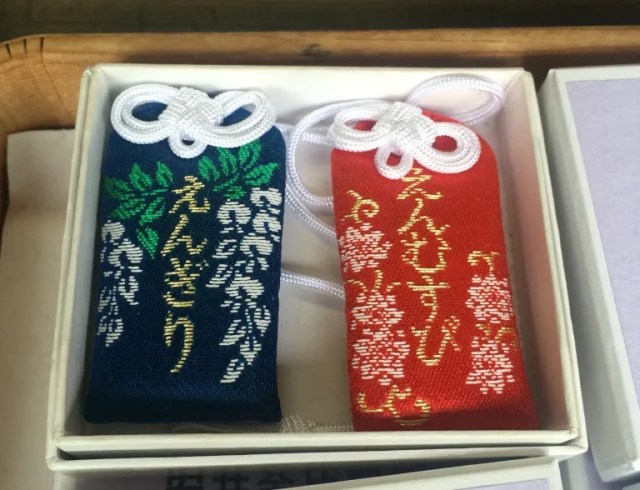
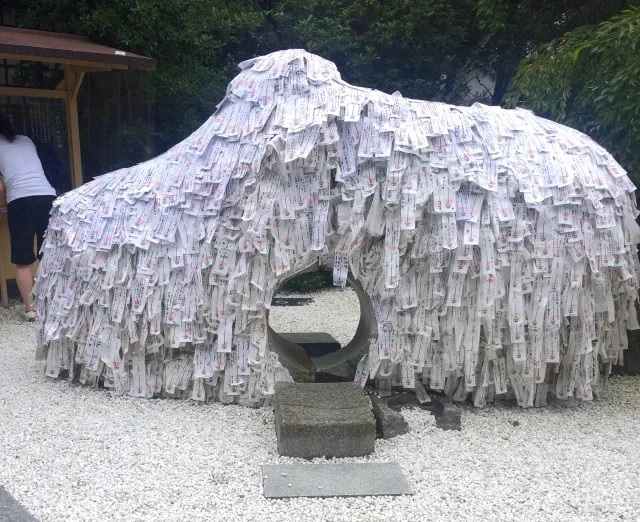
 Keep your smartphone safe in a pouch styled after Japanese Shinto/Buddhist protection amulets
Keep your smartphone safe in a pouch styled after Japanese Shinto/Buddhist protection amulets New Sputniko! music video presents modern take on traditional myth, inspired by real life science
New Sputniko! music video presents modern take on traditional myth, inspired by real life science Imitation crab meat shrine built in Kobe
Imitation crab meat shrine built in Kobe A visit to one of Japan’s motorcycle Shinto shrines
A visit to one of Japan’s motorcycle Shinto shrines Out-of-this-world omamori shrine charms are blessed by the cosmos
Out-of-this-world omamori shrine charms are blessed by the cosmos Japan’s deadliest food claims more victims, but why do people keep eating it for New Year’s?
Japan’s deadliest food claims more victims, but why do people keep eating it for New Year’s? Starbucks unveils new Valentine’s Day Frappuccino in Japan
Starbucks unveils new Valentine’s Day Frappuccino in Japan The top 10 annoying foreign tourist behaviors on trains, as chosen by Japanese people【Survey】
The top 10 annoying foreign tourist behaviors on trains, as chosen by Japanese people【Survey】 Kiki’s Deliver Service heroine gets new design from Spy x Family artist for 40th anniversary
Kiki’s Deliver Service heroine gets new design from Spy x Family artist for 40th anniversary Harry Potter and Detective Conan announce “collaboration of glasses-wearing boys”
Harry Potter and Detective Conan announce “collaboration of glasses-wearing boys” Will we roll in the riches or the dirt with Mulan Akiba’s 2025 capsule toy lucky bag?
Will we roll in the riches or the dirt with Mulan Akiba’s 2025 capsule toy lucky bag?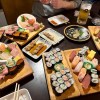 Shinjuku izakaya’s all-you-can-eat-and-drink plan is one of Tokyo’s best secret cheap eats
Shinjuku izakaya’s all-you-can-eat-and-drink plan is one of Tokyo’s best secret cheap eats How to say “I love you” in Japanese – 47 different ways 【Videos】
How to say “I love you” in Japanese – 47 different ways 【Videos】 Tokyo Space-out tournament draws nearly 100 competitors, finds who’s the best at doing nothing【Video】
Tokyo Space-out tournament draws nearly 100 competitors, finds who’s the best at doing nothing【Video】 Bad tourist manners lead to new Mt. Fuji view-blocking scree at Japan’s “Fuji convenience store”
Bad tourist manners lead to new Mt. Fuji view-blocking scree at Japan’s “Fuji convenience store” Hayao Miyazaki says Happy New Year to Studio Ghibli fans with new art for Year of the Snake
Hayao Miyazaki says Happy New Year to Studio Ghibli fans with new art for Year of the Snake McDonald’s Japan has a fukubukuro lucky bag that everyone wants to get their hands on
McDonald’s Japan has a fukubukuro lucky bag that everyone wants to get their hands on What’s in Starbucks Japan’s fukubukuro lucky bag for 2025?
What’s in Starbucks Japan’s fukubukuro lucky bag for 2025? Let’s go open a Lego Japan lucky bag…o
Let’s go open a Lego Japan lucky bag…o There’s an official PlayStation lucky bag, but what’s inside?【Photos】
There’s an official PlayStation lucky bag, but what’s inside?【Photos】 Square Enix releases a Final Fantasy fukubukuro lucky bag for New Year’s in Japan
Square Enix releases a Final Fantasy fukubukuro lucky bag for New Year’s in Japan Animate Akihabara releases a lucky bag for the first time in years, and it’s amazing
Animate Akihabara releases a lucky bag for the first time in years, and it’s amazing The perfect budget-friendly hot spring hotel near Narita Airport
The perfect budget-friendly hot spring hotel near Narita Airport Starbucks Japan’s Lucky Bag #3: A fukubukuro surprise we weren’t expecting
Starbucks Japan’s Lucky Bag #3: A fukubukuro surprise we weren’t expecting Bear breaks into house in Japan, quickly begins spending winter exactly like Japanese people do
Bear breaks into house in Japan, quickly begins spending winter exactly like Japanese people do Starbucks Japan is calling it quits with paper straws
Starbucks Japan is calling it quits with paper straws Japanese company develops classy heavy metal band frames for glasses
Japanese company develops classy heavy metal band frames for glasses This downtown Tokyo cafe is like a time machine that takes you back 50 years into the past
This downtown Tokyo cafe is like a time machine that takes you back 50 years into the past Station of despair: What to do if you get stuck at the end of Tokyo’s Chuo Rapid Line
Station of despair: What to do if you get stuck at the end of Tokyo’s Chuo Rapid Line Starbucks Japan reveals new winter holiday goods to wrap up 2024
Starbucks Japan reveals new winter holiday goods to wrap up 2024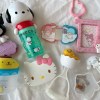 McDonald’s new Happy Meals offer up cute and practical Sanrio lifestyle goods
McDonald’s new Happy Meals offer up cute and practical Sanrio lifestyle goods Foreign tourists on Shinkansen bullet train break suitcase etiquette, angering local passengers
Foreign tourists on Shinkansen bullet train break suitcase etiquette, angering local passengers Possessing Harry Potter’s Sword of Godric Gryffindor is now illegal in Japan
Possessing Harry Potter’s Sword of Godric Gryffindor is now illegal in Japan Japanese government to make first change to romanization spelling rules since the 1950s
Japanese government to make first change to romanization spelling rules since the 1950s Foreigner’s request for help in Tokyo makes us sad for the state of society
Foreigner’s request for help in Tokyo makes us sad for the state of society Japanese convenience store Family Mart announces abolishment of eat-in spaces
Japanese convenience store Family Mart announces abolishment of eat-in spaces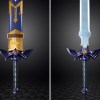 Life-size vibrating Legend of Zelda Master Sword for sale from Nintendo【Photos】
Life-size vibrating Legend of Zelda Master Sword for sale from Nintendo【Photos】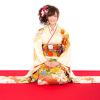 Princesses, fruits, and blacksmiths: Study reveals the 30 most unusual family names in Japan
Princesses, fruits, and blacksmiths: Study reveals the 30 most unusual family names in Japan Studio Ghibli releases free-download board game — Here’s how to play it without reading Japanese
Studio Ghibli releases free-download board game — Here’s how to play it without reading Japanese Japanese omamori good-luck charm pouches are here to protect your lips as stylish balm holders
Japanese omamori good-luck charm pouches are here to protect your lips as stylish balm holders Fake monks targeting foreign visitors to Japan?
Fake monks targeting foreign visitors to Japan? Travelers’ misguided attempt to earn good luck is damaging Japan’s most famous torii shrine gate
Travelers’ misguided attempt to earn good luck is damaging Japan’s most famous torii shrine gate Studio Ghibli releases My Neighbour Totoro range showcasing traditional Japanese craftsmanship
Studio Ghibli releases My Neighbour Totoro range showcasing traditional Japanese craftsmanship This Year of the Rabbit, visit some of the best Japanese sightseeing spots related to rabbits
This Year of the Rabbit, visit some of the best Japanese sightseeing spots related to rabbits Spirited Away meals and merchandise coming to new Studio Ghibli exhibition in Tokyo
Spirited Away meals and merchandise coming to new Studio Ghibli exhibition in Tokyo TripAdvisor Japan announces the country’s 10 favorite shrines and temples
TripAdvisor Japan announces the country’s 10 favorite shrines and temples Second anime cafe based on films of Summer Wars’ Mamoru Hosoda now open in Japan
Second anime cafe based on films of Summer Wars’ Mamoru Hosoda now open in Japan Tottori’s shrines have some of the most adorable charms you’ve ever seen!
Tottori’s shrines have some of the most adorable charms you’ve ever seen! Cool and fun paper craft from the makers of Akafuku — one of Japan’s favorite sweets!
Cool and fun paper craft from the makers of Akafuku — one of Japan’s favorite sweets! Japanese Lucky Beckoning Cat banknote design is the faux money we wish was real
Japanese Lucky Beckoning Cat banknote design is the faux money we wish was real This beautiful, traditional Japanese building is actually a fully modern convenience store
This beautiful, traditional Japanese building is actually a fully modern convenience store New hair pins let you look like you’ve been stabbed in the head with a classic Japanese icon
New hair pins let you look like you’ve been stabbed in the head with a classic Japanese icon New ‘Shrine Cafe’ in Tokyo offers fortune-telling and counseling services with your tea
New ‘Shrine Cafe’ in Tokyo offers fortune-telling and counseling services with your tea Japanese voodoo dolls with foreign politician photo keep getting nailed to town’s shrine trees
Japanese voodoo dolls with foreign politician photo keep getting nailed to town’s shrine trees At this Kyoto shrine, be careful what you wish for—and how—, because you just might get it
At this Kyoto shrine, be careful what you wish for—and how—, because you just might get it
Leave a Reply